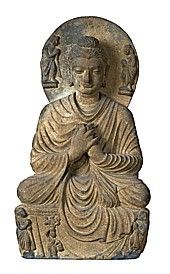 | Focusing on the development of Buddhist statues throughout history, starting from the Ancient India to China, Korea and Japan, the new exhibition hosted by the Tokyo National Museum is a true cultural event. The organisers have chosen several representative statues, all of them briliant works of art, to show how the Buddhist beliefs and art have evolved and changed over centuries in each region.
Buddhism is essentially a religion and system of beliefs based on the teachings of Prince Siddhartha Gautama, who lived in India around the 5th century B.C. He eventually became Sakyamuni Buddha, at the age of 35, and preached for the rest of his life. After his passing, his followers kept the religion alive. The first Buddhish works of art were the stupas, mound-like structures, where the ashes and relics of the Enlightened One were placed. This stupas were richly decorated with reliefs, inspired by stories of Buddha's life. |
The first depictions of Buddha as a human being date from the 1st century AD, and in the following centuries the statues would end up playing a key role in Buddhism. The show at the Tokyo National Museum reunites some of the best examples..
Photo : tnm.go.jp
2007-08-21

































